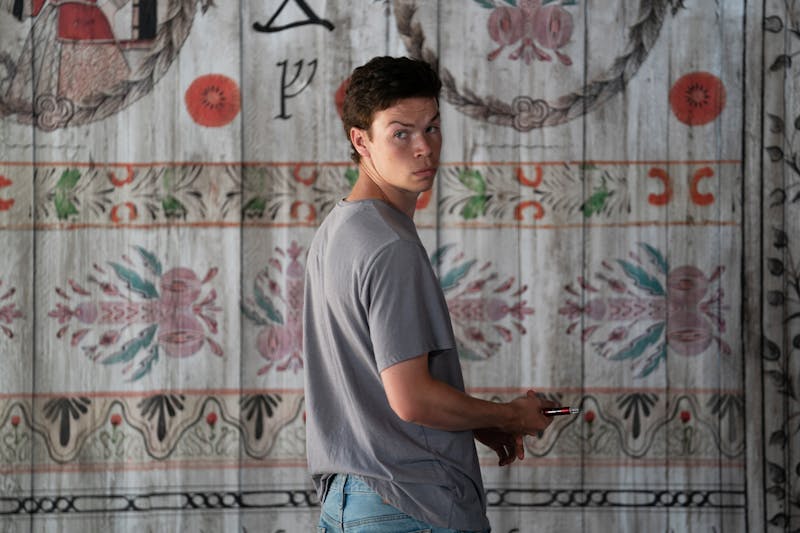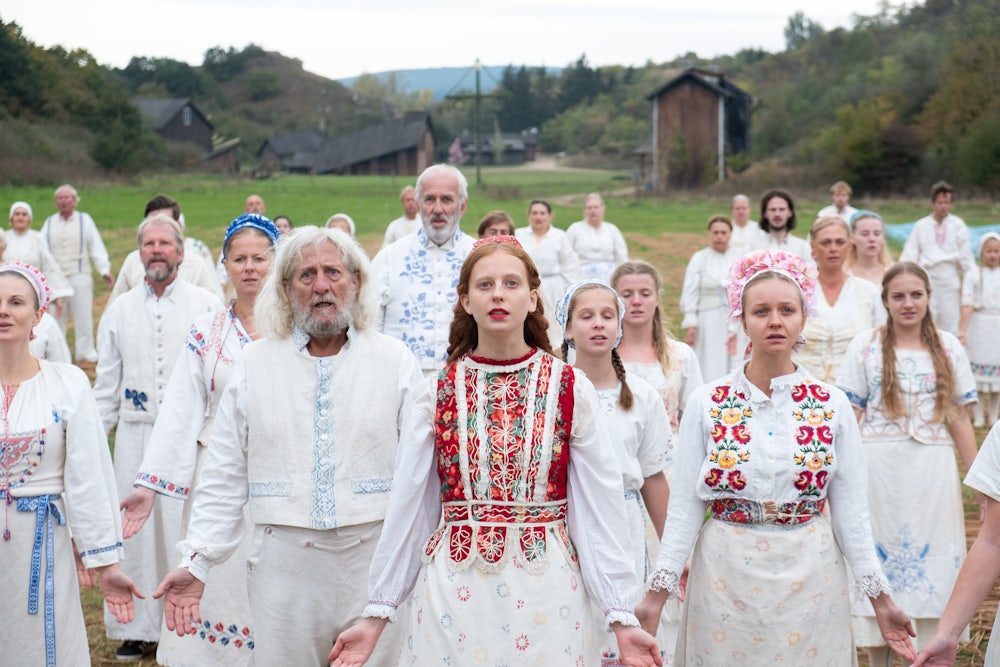Are you afraid of the dark? If so, Ari Aster’s debut movie, last year’s Hereditary, may have been too much to take. Its tale of familial dysfunction and repressed trauma was enriched by its gloomy color palette, taking place mostly inside a badly-lit home or outside, at night. Now Aster returns with Midsommar, which couldn’t be more different: Its action occurs under the unsparing, perpetual daylight of a Scandinavian summer. But sunshine can be crueler than the dark, because there is nowhere to hide.
The movie begins in snowbound America, where we meet our heroine Dani (Florence Pugh). She’s a sweet-faced college student, traumatized by a terrible family tragedy. She clings to a callous boyfriend named Christian (Jack Reynor), who is more interested in hanging out with his gang of grad school mates, including a Swede named Pelle. Christian wants to dump her but feels guilty about it—it’s a toxic dynamic, and the dread starts to build. The boys have a trip to rural Sweden planned, where they will visit Pelle’s home. He comes from a close-knit community, he explains, that is about to throw a once-every-90-years midsummer festival. Dani tags along out of lonely desperation.

A bizarre scene lies before the Americans. Delighted to be among the Swedish tribe at last, they accept the odd food offered them and revel in the sunshine. The Swedes are all dressed in white garb and prone to bursting into traditional song and dance. The fictional tribe’s customs owe a lot to actual Swedish tradition—the white dresses and floral headdresses of the real Midsommar festival are authentic—but their eccentric beliefs toe the line between religiosity and spookiness. They practice an inscrutable independent religion anchored by oracular prophecy, and live in a system of barns that look like they were decorated by an unusually cheerful brotherhood of medieval monks. (Think medieval fresco, but brighter.) The production designer, Henrik Svensson, has built a truly frightening and intricate universe whose iconography is dominated by symmetry.
The Americans find it all fascinating. But as the tribe gets weirder, the Americans start to misbehave. Their manners are awful, and the nastiest of them, a boy named Mark (Will Poulter), accidentally takes a leak on a holy ceremonial tree. Josh (William Jackson Harper) sneaks into the temple at night.
To say more about what follows would be to ruin the plot. Suffice to say that the tribe is preparing for a traditional northern European–style fertility festival, complete with a girl crowned the May Queen. Because all this is framed by the movie’s tragic overture, Dani’s unresolved pain becomes intertwined with the strange proceedings. Amid all this confusing stimulus she tries to simply keep going, one foot in front of the other, day by day. But under the vicious glare of the Scandinavian sun something seems to shake loose inside Dani, as if she has some special affinity with the ritual magic of Pelle’s tribe. As the fertility rites begin to pick up pace, the relationships between the American tourists start to shift. Something, or someone, is about to change.
Midsommar is almost two movies: a beautifully realized piece of unusual cinema, and a rush-job that needed more time to have its edges knocked off. Among the movie’s strengths are its glaring yet muted color palette, which thrums with pale shades of yellow and blue—a callback to the low-fi Technicolor of vintage horror flicks like Black Narcissus (1947). The cinematography is daring: As the American tourists drive towards the tribe’s land, for example, a truly impressive orbital shot begins by following their car from behind, before rising up into the air and over the vehicle until we are watching it driving toward us—upside down. Aster’s vision takes on a kind of monstrous pageantry, as if the camera itself has malign intentions.
The problems lie in Midsommar’s inconsistencies. The film is clearly supposed to be set in late June, during the summer solstice. This is perfectly fine, except for the fact that the plot circles around the crowning of a May Queen, which happens in May.* Midsommar wants to be set in two different months at once, which is impossible and compromises the internal logic of the tribe’s theology.

Spoilers also abound in Midsommar, in the form of runes. Runes once formed a real alphabet used in northern Europe, prior to the arrival of the Latin alphabet. Plenty of modern people know what they mean from their presence in occult practices (like casting runes to predict the future) and on medieval stones that still stand today. Runes are all over Midsommar: embroidered on clothes, hanging on their maypole structure, painted on the walls. They form a lovely bit of world-building, and successfully convey the choking effect of superstition on small communities. In addition to being very pretty (you can see a rune to the left of Mark’s head in the image above), they lend poetry to the movie’s scenery, like the two that appear on the maypole: fehu, which symbolizes wealth, and raido, which means a journey. “Success-journey” is a good runic translation for a maypole dance, since the girls have to travel around it to generate good luck.
The spoilers come when the symbols literally inform the reader what is about to happen next. If I told you what the rune sewn onto Christian’s tunic means, it would give away the entire plot—it’s the name of a mythical Scandinavian god who meets a very specific fate. A mysterious barn is inscribed all over with the Gar rune, a powerful symbol designating—something that also would give away the plot. So the runes end up working more as blatant signposts than hints. There are some lovely invented symbols in the movie, part of the tribe’s religious language, “Affekt.” Those symbols could have been expanded, circumventing the crude use of actual runes.
The reason these little missteps matter is that they show that Midsommar was rushed, and could have benefited from just a little more thought. According to an interview Aster gave to Emily Yoshida of Vulture, Hereditary and Midsommar were filmed almost on top of each other due to scheduling issues. As a result, Aster seems to have lost sight of some important details. In addition to the timeline and symbology being off, the characterization is patchy. Aster’s commitment to his heroine’s psychological journey is admirable, but that doesn’t hold true for everybody in the film. Midsommar features a key child character named Reuben with a visible disability, as Hereditary also did (actress Milly Shapiro, who played Charlie, has cleidocranial dysplasia). Aster recently said that Rueben is “important more as a symbol, as an idea, than he is even as a character,” and that he represents the movie’s politics. But as far as I can tell, Reuben and Charlie denote a kind of unformed evil through their physical difference, which is a pretty lazy way to denote wickedness.
Aster obviously has enormous talent, not least for picking original and creative collaborators (look out for the ravishing wallpaper designed by artist Ragnar Persson—it’s full of easter eggs). If only he had had a few more months to iron out those kinks, and develop those latent themes. The movie he has made is compelling, frightening, and at times exquisitely beautiful. But his errors should stand as a warning to the next hot young thing whose distributor or studio wants them to work at a pace the medium cannot support. As the Swedes say, Den som väntar på något gått han väntar aldrig för länge—you can never wait too long for something good.
*A former version of this article incorrectly stated that maypole dances do not happen in midsummer in Sweden.
